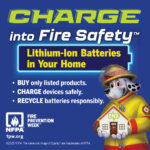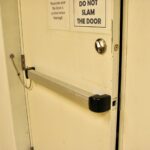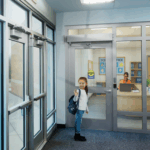Here is my second draft script for an upcoming whiteboard animation video. I really appreciate everyone who made suggestions for yesterday’s script – I have made some changes. Please comment if there is anything I need to add or change for this video about a very important topic.
Options for Securing Classroom Doors [Draft Script]
Methods for securing classroom doors is one aspect of school security that should be addressed in the emergency plans for a school. During an active shooter incident or other lockdown situation, students and teachers may need to shelter-in-place behind a locked classroom door, or evacuate to a safe location if necessary. It’s important to plan for both possibilities.
The Final Report of the Sandy Hook Advisory Commission includes several recommendations regarding classroom doors, including Recommendation #1 – classroom doors should be lockable from inside the classroom. Another recommendation of this report addresses the distribution of keys to all staff including substitute teachers. The report states: “The testimony and other evidence presented to the Commission reveals that there has never been an event in which an active shooter breached a locked classroom door.” Traditional locksets provide the required level of security for classroom doors, but it is important to consider the location, type, and size of glazing adjacent to the hardware to ensure that the lockset cannot be defeated by breaking the glass.
The National Association of State Fire Marshals – or NASFM, has published a set of guidelines for classroom door security. In some jurisdictions, these recommendations may be mandatory depending on applicable codes, laws, and regulations. The guidelines include classroom door hardware that meets the following criteria:
- Hardware that is lockable from inside the classroom without opening the door, to minimize the teacher’s exposure
- Access from outside of the classroom by emergency responders using a key or other credential
- Egress without a key, tool, special knowledge or effort, and one operation to unlatch the door
- Operable hardware mounted between 34 inches and 48 inches above the floor, and no tight grasping, tight pinching, or twisting of the wrist to operate, with the bottom 10 inches on the push side of manual doors a flush, smooth surface
- If a classroom door is fire rated, the door must be self-closing and self-latching, and may not be modified in a way that invalidates the fire rating
There are many retrofit security devices (also known as barricade devices) on the market today which do not meet these guidelines. These devices typically barricade the door, delaying or preventing egress and often making it impossible for staff and emergency responders to open the door from the outside. Check the local code requirements to determine whether these devices are allowed by the Authority Having Jurisdiction.
There are several lock functions that are commonly used in schools, and there are pros and cons to each. All of the following lock functions allow immediate egress and authorized access, in accordance with the NASFM guidelines.
- The classroom security function allows a teacher to lock the outside lever without opening the door, by inserting a key in the cylinder on the inside lever. While the use of a key ensures that only an authorized person can lock the classroom door, some staff members may have difficulty using fine motor skills to lock the door in a high-stress situation. Lockdown drills and practice will help to familiarize teachers with the operation of the lock, and an indicator will confirm that the lock has been put into lockdown.
- An entrance function or office function lock is locked by turning a thumbturn or pushing a button on the inside lever. This makes it easy to lock the outside lever without opening the door, but it is also possible for the door to be locked by an unauthorized person, including someone who may want to secure a classroom to commit an assault, theft, vandalism or other crime. If this lock function is used, staff should carry keys to unlock the door from the outside in case of unauthorized lockdown.
- A storeroom function lock always requires a key to retract the latch and enter the room. A classroom lock can be locked or unlocked using a key in the outside lever, but would require a teacher to open the door to do so. Many schools have existing classroom locks, and some have instituted a policy in which the classroom is kept locked at all times, making the lock’s operation similar to a storeroom function lock. This strategy makes sense when budgetary constraints prevent replacement of the locks with a function that can be locked without opening the door, but it can be inconvenient to keep the doors locked all the time.
- Electronic classroom locks are available that are locked by pressing a button on a fob worn by staff members. Some locks can be locked remotely or as a system-wide lockdown. Using a fob removes the concern about the fine-motor skills necessary for inserting and turning a key, and lockdown cannot be initiated by an unauthorized person who is not in possession of the fob, but the cost of replacing existing locks with an electronic product may not be feasible for all facilities.
Remember, all of these lock functions allow free egress by turning the inside lever, as required by the model codes. In addition, all of these options allow authorized access from the outside by staff or emergency responders. Balancing life safety with security is critical when choosing a locking method for classroom doors. For more information on classroom door locks and other school security topics, visit www.iDigHardware.com/schools.
You need to login or register to bookmark/favorite this content.





If an internal key type device is used it MUST be cross keyed so ANY key, not just the change key to the individual room, can be used to secure the door. Substitutes or part-time teachers need to be issued “day” keys and taught how to use them.
I’m having a problem at an elementary campus in the life skills area. We have a child that will open the door and run. They had installed a dead bolt lock about 5′ from the floor. I removed the dead bolt when I re-keyed the campus, but the teacher is very concerned because this child is very fast! Do you have any suggestions to secure this room? I’ve recommended rearranging the room so the child will have to go around the teachers desk but this can cause egress issues.
Hi Keith –
That’s a common problem and right now the codes don’t give you many options. You could have a deadbolt at 5′ AFF if that was the only lock/latch on the door, it had a thumbturn that could be operated without tight grasping, tight pinching, or twisting of the wrist, and it was a door that did not require panic hardware.
The BHMA Codes & Government Affairs Committee has submitted a proposal for the 2018 IBC to allow delayed egress on certain classroom doors. It was intended to address day care and special needs classrooms so the occupant load in the proposal is a maximum of 10. This wouldn’t help with the typical classroom.
You could ask your AHJ for a modification, but they are usually hesitant to do that. You could put an alarm on the door, but that doesn’t completely solve the problem. I asked this question of a group of code officials a while back and one suggestion was to fence an area outside so he couldn’t get as far. If the fenced area is large enough to accommodate the occupants as a safe dispersal area, you could contain the kid in that area without allowing egress through a gate. Not an inexpensive solution, but it could work in some locations.
– Lori
I used to work for a large school district and we would get requests for “egress prevention” on a regular basis. Really, the only viable option is something like a delayed egress mag lock that would alarm long enough to secure the child before opening. That, with either a high-mounted REX button, a keypad, or a credential reader is about the only way it can be done and still maintain egress requirements. I currently work at a county hospital that uses delayed egress mag locks for child care. It’s expensive and a little inconvenient, but it works.
At root though, the only solution is supervision. Delayed egress helps, but ultimately it comes down to the fact that those children need to be able to exit the classroom without adult help in an emergency.
Rather than an office functioning use a corridor function lock. When the door closes the button pops out or the thumb turn resets. I both cases the outside cylinder is classroom function, so you can’t get locked out
Lori
While it not a code issue yet, my experience is during high stress many personnel even though “trained” forget how to lock the lock. Therefore a recommendation should be clear bold identification on the lock on which way to turn the key – either from the manufacture or a sign on the door or the lock.
Paul
Lori, locally in new construction we have used an E-CX9975L when there is a problem with students running out of the classroom. This allows the teacher to have emergency lock down with a simple light switch type switch on the inside of the classroom locking the outside trim, but still allowing emergency key over ride when locked down and when the delayed egress CX is powered up.